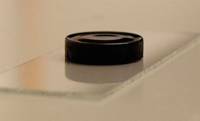Electronics News
Archive : 5 March 2019 год
 McMaster researchers, working with partners at other universities, have created a motion-powered, fireproof sensor that can track the movements of firefighters, steelworkers, miners and others who work in high-risk environments where they cannot always be seen.
McMaster researchers, working with partners at other universities, have created a motion-powered, fireproof sensor that can track the movements of firefighters, steelworkers, miners and others who work in high-risk environments where they cannot always be seen.
The low-cost sensor is about the size of a button-cell watch battery and can be incorporated into the sole of a boot or under the arm of a jacket - wherever motion creates a pattern of constant contact and release to generate the power the sensor needs to operate.
The sensor uses triboelectric, or friction-generated, charging; harvesting electricity from movement in much the same way that a person in socks picks up static electricity walking across a carpet.
The sensor can track the movement and location of a person in a burning building, a mineshaft or other hazardous environment, alerting someone outside if the movement ceases.
The key material in the sensor, a new carbon aerogel nanocomposite, is fireproof, and the device never needs charging from a power source.
"If somebody is unconscious and you are unable to find them, this could be very useful," says Ravi Selvaganapathy, a professor of mechanical engineering who oversaw the project. "The nice thing is that because it is self-powered, you don't have to do anything. It scavenges power from the environment."
The research team - from McMaster, UCLA and University of Chemistry and Technology Prague - explain that previously developed self-powered sensors have allowed similar tracking, but their materials break down at high temperatures, rendering them useless,
A self-powered sensor is necessary in extreme heat because most batteries also break down in high temperatures. The researchers have successfully tested the new technology at temperatures up to 300C - the temperature where most types of wood start to burn - without any loss of function.
The researchers hope to work with a commercial partner to get the technology to market.
Author
Bethan Grylls
Source: www.newelectronics.co.uk
 MIT researchers have developed a novel cryptography circuit that can be used to protect low-power IoT devices in the coming age of quantum computing.
MIT researchers have developed a novel cryptography circuit that can be used to protect low-power IoT devices in the coming age of quantum computing.
Bringing quantum computers online and to market could one day enable advances in areas such as medical research, but if hackers get access, they could potentially break through the powerful encryption schemes that currently protect data exchanged between devices.
Today’s most promising quantum-resistant encryption scheme is called “lattice-based cryptography,” which hides information in complex mathematical structures. To date, no known quantum algorithm can break through its defences. But these schemes are way too computationally intense for IoT devices, which can only spare enough energy for simple data processing.
Now, MIT researchers describe a new kind of circuit architecture and statistical optimisation tricks that can be used to efficiently compute lattice-based cryptography. The 2mm2 chips are said to be efficient enough for integration into any current IoT device.
The architecture is customisable to accommodate the multiple lattice-based schemes currently being studied in preparation for the day that quantum computers come online.
The researchers say the circuit is the first of its kind to meet standards for lattice-based cryptography set by the National Institute of Standards and Technology (NIST).
Generating random numbers is the most important part of all cryptography schemes, according to MIT. This is because those numbers are used to generate secure encryption keys that can’t be predicted. That’s calculated through a two-part process called “sampling.”
After analysing all available methods for sampling, the researchers found that one method, called SHA-3, can generate many pseudorandom numbers two or three times more efficiently than all others. They tweaked SHA-3 to handle lattice-based cryptography sampling. On top of this, they applied some mathematical tricks to make pseudorandom sampling, and the postprocessing conversion to new distributions, faster and more efficient.
They run this technique using energy-efficient custom hardware that takes up only 9 per cent of the surface area of their chip. In the end, this makes the process of sampling two orders of magnitude more efficient than traditional methods.
For their circuit design, the researchers modified a technique called “number theoretic transform” (NTT), which functions similarly to the Fourier transform mathematical technique that decomposes a signal into the multiple frequencies that make it up. The modified NTT splits vector data and allocates portions across four single-port RAM devices. Each vector can still be accessed in its entirety for sampling as if it were stored on a single multiport device. The benefit is the four single-port REM devices occupy about a third less total area than one multiport device.
“We basically modified how the vector is physically mapped in the memory and modified the data flow, so this new mapping can be incorporated into the sampling process. Using these architecture tricks, we reduced the energy consumption and occupied area, while maintaining the desired throughput,” said the first author of the paper, Utsav Banerjee, and a graduate student in electrical engineering and computer science.
The circuit also incorporates a small instruction memory component that can be programmed with custom instructions to handle different sampling techniques - such as specific probability distributions and standard deviations - and different vector sizes and operations. This is especially helpful, as lattice-based cryptography schemes will most likely change slightly in the coming years and decades.
Author
Bethan Grylls
Source: www.newelectronics.co.uk
 A team from the University of Cambridge has developed an inkjet-printed transistor, which is sensitive enough to accurately detect electrophysiological signals from the skin when used in conjunction with a wearable device.
A team from the University of Cambridge has developed an inkjet-printed transistor, which is sensitive enough to accurately detect electrophysiological signals from the skin when used in conjunction with a wearable device.
In the virtual environment, for example, the tracking of subtle eye movements by electro-oculography is needed for a better, more realistic depiction which relies on elements such as depth of field rendering. Compared to other thin film technologies such as silicon or metal oxides, the transistor’s power consumption is one thousand times less and the signal-to-noise ratio one hundred times better.
The results demonstrate the potential of using low-cost inkjet-printing technology to directly integrate biomaterials with electronics, in order to create new applications at the forefront of the electronics-biology interface, such as the tracking of eye movements in virtual and augmented reality.
“This is the first time such a high performance printed transistor has been achieved that demonstrates good reliability over several months, without changing characteristics,” said Dr Chen Jiang, the paper’s first author. “This transistor improves upon typical organic transistors that have a lower level of reliability of just a few days or even a few hours.”
Dr David Hasko, the paper’s co-author from the Department of Engineering, said: “This application demonstrates a further example of how it is possible to fabricate a whole circuit using just a single, highly affordable, inkjet printing tool that puts a fabrication plant within reach of most university departments. It would be an excellent way of introducing, for example, design rules and micro-fabrication in a practical way.”
Author
Bethan Grylls
Source: www.newelectronics.co.uk
